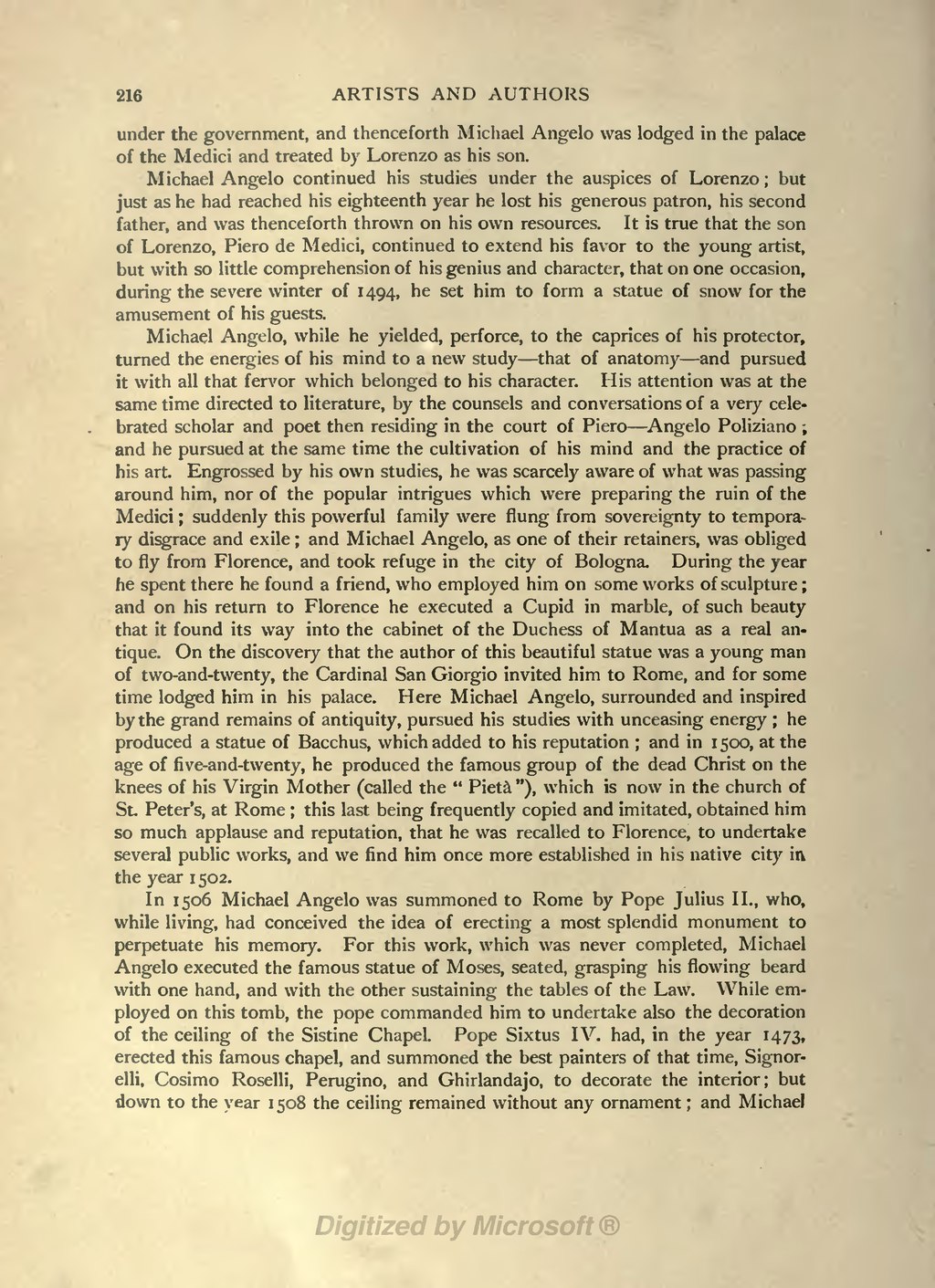216 ARTISTS AND AUTHORS under the government, and thenceforth Michael Angelo was lodged in the palace of the Medici and treated by Lorenzo as his son. Michael Angelo continued his studies under the auspices of Lorenzo ; but just as he had reached his eighteenth year he lost his generous patron, his second father, and was thenceforth thrown on his own resources. It is true that the son of Lorenzo, Piero de Medici, continued to extend his favor to the young artist, but with so little comprehension of his genius and character, that on one occasion, during the severe winter of 1494, he set him to form a statue of snow for the amusement of his guests. Michael Angelo, while he yielded, perforce, to the caprices of his protector, turned the energies of his mind to a new study — that of anatomy — and pursued it with all that fervor which belonged to his character. His attention was at the same time directed to literature, by the counsels and conversations of a very cele- brated scholar and poet then residing in the court of Piero — Angelo Poliziano ; and he pursued at the same time the cultivation of his mind and the practice of his art. Engrossed by his own studies, he was scarcely aware of what was passing around him, nor of the popular intrigues which were preparing the ruin of the Medici ; suddenly this powerful family were flung from sovereignty to tempora- ry disgrace and exile ; and Michael Angelo, as one of their retainers, was obliged to fly from Florence, and took refuge in the city of Bologna. During the year he spent there he found a friend, who employed him on some works of sculpture ; and on his return to Florence he executed a Cupid in marble, of such beauty that it found its way into the cabinet of the Duchess of Mantua as a real an- tique. On the discovery that the author of this beautiful statue was a young man of two-and-twenty, the Cardinal San Giorgio invited him to Rome, and for some time lodged him in his palace. Here Michael Angelo, surrounded and inspired by the grand remains of antiquity, pursued his studies with unceasing energy ; he produced a statue of Bacchus, which added to his reputation ; and in 1500, at the age of five-and-twenty, he produced the famous group of the dead Christ on the knees of his Virgin Mother (called the " Pieta "), which is now in the church of St. Peter's, at Rome ; this last being frequently copied and imitated, obtained him so much applause and reputation, that he was recalled to Florence, to undertake several public works, and we find him once more established in his native city in the year 1502. In 1506 Michael Angelo was summoned to Rome by Pope Julius II., who, while living, had conceived the idea of erecting a most splendid monument to perpetuate his memory. For this work, which was never completed, Michael Angelo executed the famous statue of Moses, seated, grasping his flowing beard with one hand, and with the other sustaining the tables of the Law. While em- ployed on this tomb, the pope commanded him to undertake also the decoration of the ceiling of the Sistine Chapel. Pope Sixtus IV. had, in the year 1473, erected this famous chapel, and summoned the best painters of that time, Signor- elli, Cosimo Roselli, Perugino, and Ghirlandajo, to decorate the interior; but down to the year 1508 the ceiling remained without any ornament ; and Michael
